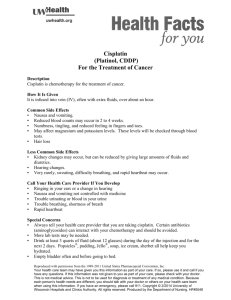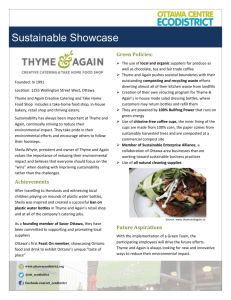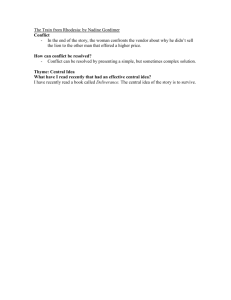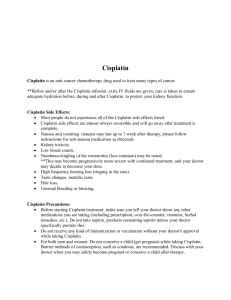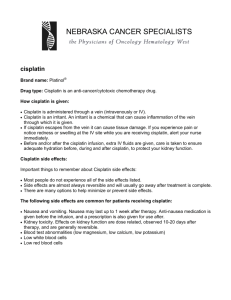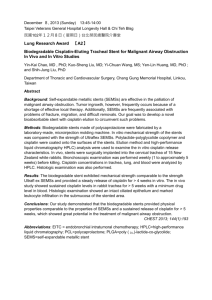Document 13310210
advertisement
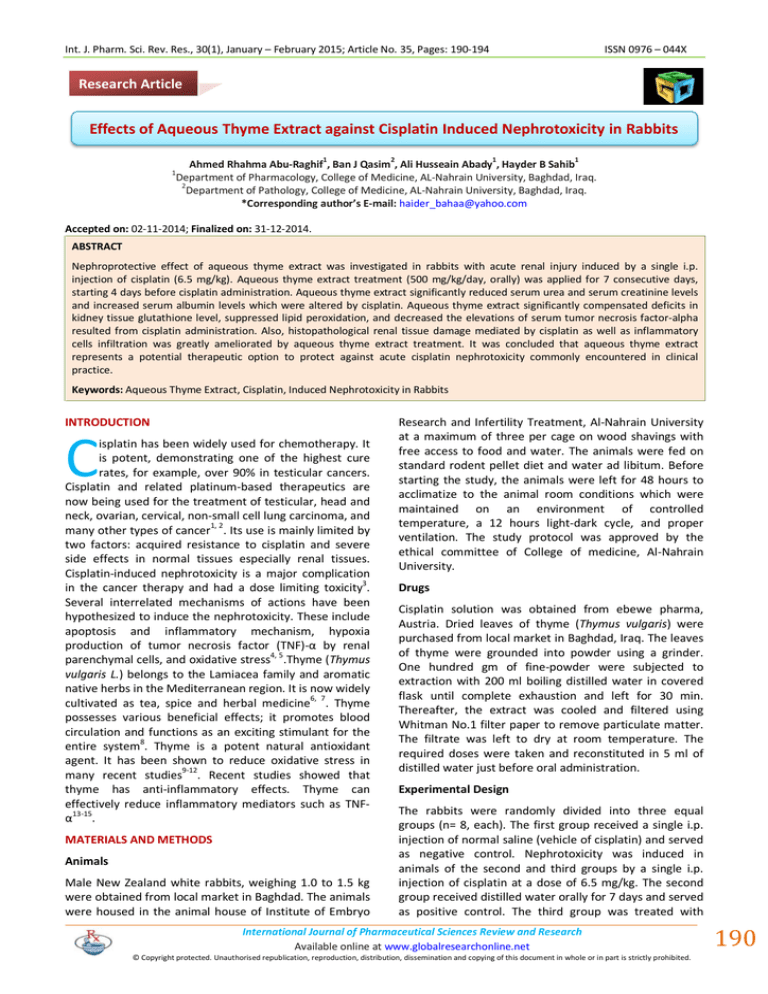
Int. J. Pharm. Sci. Rev. Res., 30(1), January – February 2015; Article No. 35, Pages: 190-194 ISSN 0976 – 044X Research Article Effects of Aqueous Thyme Extract against Cisplatin Induced Nephrotoxicity in Rabbits 1 1 2 1 1 Ahmed Rhahma Abu-Raghif , Ban J Qasim , Ali Husseain Abady , Hayder B Sahib Department of Pharmacology, College of Medicine, AL-Nahrain University, Baghdad, Iraq. 2 Department of Pathology, College of Medicine, AL-Nahrain University, Baghdad, Iraq. *Corresponding author’s E-mail: haider_bahaa@yahoo.com Accepted on: 02-11-2014; Finalized on: 31-12-2014. ABSTRACT Nephroprotective effect of aqueous thyme extract was investigated in rabbits with acute renal injury induced by a single i.p. injection of cisplatin (6.5 mg/kg). Aqueous thyme extract treatment (500 mg/kg/day, orally) was applied for 7 consecutive days, starting 4 days before cisplatin administration. Aqueous thyme extract significantly reduced serum urea and serum creatinine levels and increased serum albumin levels which were altered by cisplatin. Aqueous thyme extract significantly compensated deficits in kidney tissue glutathione level, suppressed lipid peroxidation, and decreased the elevations of serum tumor necrosis factor-alpha resulted from cisplatin administration. Also, histopathological renal tissue damage mediated by cisplatin as well as inflammatory cells infiltration was greatly ameliorated by aqueous thyme extract treatment. It was concluded that aqueous thyme extract represents a potential therapeutic option to protect against acute cisplatin nephrotoxicity commonly encountered in clinical practice. Keywords: Aqueous Thyme Extract, Cisplatin, Induced Nephrotoxicity in Rabbits INTRODUCTION C isplatin has been widely used for chemotherapy. It is potent, demonstrating one of the highest cure rates, for example, over 90% in testicular cancers. Cisplatin and related platinum-based therapeutics are now being used for the treatment of testicular, head and neck, ovarian, cervical, non-small cell lung carcinoma, and many other types of cancer1, 2. Its use is mainly limited by two factors: acquired resistance to cisplatin and severe side effects in normal tissues especially renal tissues. Cisplatin-induced nephrotoxicity is a major complication in the cancer therapy and had a dose limiting toxicity3. Several interrelated mechanisms of actions have been hypothesized to induce the nephrotoxicity. These include apoptosis and inflammatory mechanism, hypoxia production of tumor necrosis factor (TNF)-α by renal 4, 5 parenchymal cells, and oxidative stress .Thyme (Thymus vulgaris L.) belongs to the Lamiacea family and aromatic native herbs in the Mediterranean region. It is now widely 6, 7 cultivated as tea, spice and herbal medicine . Thyme possesses various beneficial effects; it promotes blood circulation and functions as an exciting stimulant for the 8 entire system . Thyme is a potent natural antioxidant agent. It has been shown to reduce oxidative stress in many recent studies9-12. Recent studies showed that thyme has anti-inflammatory effects. Thyme can effectively reduce inflammatory mediators such as TNFα13-15. MATERIALS AND METHODS Animals Male New Zealand white rabbits, weighing 1.0 to 1.5 kg were obtained from local market in Baghdad. The animals were housed in the animal house of Institute of Embryo Research and Infertility Treatment, Al-Nahrain University at a maximum of three per cage on wood shavings with free access to food and water. The animals were fed on standard rodent pellet diet and water ad libitum. Before starting the study, the animals were left for 48 hours to acclimatize to the animal room conditions which were maintained on an environment of controlled temperature, a 12 hours light-dark cycle, and proper ventilation. The study protocol was approved by the ethical committee of College of medicine, Al-Nahrain University. Drugs Cisplatin solution was obtained from ebewe pharma, Austria. Dried leaves of thyme (Thymus vulgaris) were purchased from local market in Baghdad, Iraq. The leaves of thyme were grounded into powder using a grinder. One hundred gm of fine-powder were subjected to extraction with 200 ml boiling distilled water in covered flask until complete exhaustion and left for 30 min. Thereafter, the extract was cooled and filtered using Whitman No.1 filter paper to remove particulate matter. The filtrate was left to dry at room temperature. The required doses were taken and reconstituted in 5 ml of distilled water just before oral administration. Experimental Design The rabbits were randomly divided into three equal groups (n= 8, each). The first group received a single i.p. injection of normal saline (vehicle of cisplatin) and served as negative control. Nephrotoxicity was induced in animals of the second and third groups by a single i.p. injection of cisplatin at a dose of 6.5 mg/kg. The second group received distilled water orally for 7 days and served as positive control. The third group was treated with International Journal of Pharmaceutical Sciences Review and Research Available online at www.globalresearchonline.net © Copyright protected. Unauthorised republication, reproduction, distribution, dissemination and copying of this document in whole or in part is strictly prohibited. 190 © Copyright pro Int. J. Pharm. Sci. Rev. Res., 30(1), January – February 2015; Article No. 35, Pages: 190-194 treated with Thymus Vulgaris aqueous extract 500mg/ kg/ day for 7 consecutive days starting 4 day before cisplatin administration. Sample preparation and biochemical analysis The animals were sacrificed 72 hours following cisplatin administration. The blood aspirated from rabbits’ heart was immediately transferred into plastic test tubes without anticoagulant and allowed to clot overnight at 4°C before centrifugation for 15 minutes at 1000 rpm. The supernatant (serum) was carefully aspirated and transferred into another clean plastic test tube, then stored in refrigerator at -20°C for subsequent measurement of serum urea, serum creatinine, and serum albumin using colorimetric assay kits according to the instructions of the manufacturer (BioMérieux, France). Serum TNF-α levels was measured using ELISA kit according to the instructions of the manufacturer (Cusabio, China). Kidneys were extracted free of their peritoneal attachments. Right kidneys were placed in 10% neutral buffered formalin for histopathological examination while left kidneys were homogenized in Phosphated buffered saline (PBS) and stored overnight in the refrigerator at -20°C. After two freeze-thaw cycles were performed to break the cell membranes, the homogenates were centrifuged for 5 minutes at 5000 rpm at 2 - 8°C. The supernatant was collected and stored at -20°C to be used for the estimation of tissue glutathione (GSH) and tissue malondialdehyde (MDA) by ELISA according to the instructions of the kit’s manufacturer (Cusabio, China). Histopathological examination of renal tissue The right kidneys were fixed in10% formalin solution and then dehydrated in ascending grades of alcohol and embedded in paraffin. Sections at 5µm-thickness were taken, stained with hematoxylin and eosin (H&E) and examined under light microscope by a pathologist unaware of the treatment conditions. Scores were assigned according to the percentage of cortical tubules having epithelial necrosis Scores were assigned according to the percentage of cortical tubules having epithelial necrosis by examining 10 high power fields per kidney under higher power magnification (x200) (Table 1). Table 1: Cortical tubular necrosis scores Score Percentage of tubules with necrosis 0 0% 1 <10% 2 10%-25% 3 26%-75% 4 >75% The number of neutrophils per high-power field (x400) was counted by investigator blinded to treatment ISSN 0976 – 044X conditions and the average number in 10 fields of each sample was recorded16. Statistical analysis Statistical analysis was performed using IBM SPSS version 21 statistical software and Microsoft Excel 2010. Descriptive statistics for the numerical data were formulated as mean and standard error. Parametric independent samples t-tests were carried out for comparison between two groups whenever data were normally distributed, while non-parametric MannWhitney U tests were carried out whenever the data were not normally distributed. The significant difference level (p-value) is below 0.05. RESULTS Effects of thyme extract on renal function and TNF-α Cisplatin administration (6.5 mg/ kg I.P.) resulted in significant increase in serum urea, serum creatinine, serum TNF-α and decrease in serum albumin levels compared to the negative control. Treatment with thyme extract resulted in a significant reduction in serum urea, serum creatinine, serum TNF-α and restoring serum albumin levels to the normal range (Tables 2, 3) (Figure 1). Effects of thyme extract on oxidative stress parameters Treatment with thyme extract significantly ameliorated the depletion of the antioxidant defense mechanisms (GSH level) and suppressed lipid peroxidation (MDA level) in renal tissue resulted from cisplatin administration (Tables 2, 3) (Figure 1). Effects of thyme extract on renal histopathology Kidney sections of the positive control group showed renal damage mostly in form of glomerular and tubular injury. The tubular injury is seen mostly in the proximal convoluted tubules. Some of the renal tubules are distended and dilated with proteinaceous casts especially in severe nephrotoxicity. Glomerular damage including glomerular capillary necrosis with obliteration of capillary lumens and increase of cellularity as a result of acute inflammatory cells infiltration (neutrophils) and mesangial cells hyperplasia resulting in the reduction of the glomerular filteration rate and protein urea with cast formation in renal tubules. Kidney sections of thyme extract treated group showed nearly normal histological picture with minimal pathological changes (Figure 2). Thyme extract had reduced the cortical tubular necrosis score in this study compared to the positive control group and the difference was highly statistically significant. Thyme extract also seems to reduce the neutrophil count very effectively. There was a highly statistically significant difference (lower neutrophil count) in the thyme group compared to the positive control group (Tables 2, 3) (Figure 3). International Journal of Pharmaceutical Sciences Review and Research Available online at www.globalresearchonline.net © Copyright protected. Unauthorised republication, reproduction, distribution, dissemination and copying of this document in whole or in part is strictly prohibited. 191 © Copyright pro Int. J. Pharm. Sci. Rev. Res., 30(1), January – February 2015; Article No. 35, Pages: 190-194 Table 2: Comparison between negative control group (normal group) and positive control group (cisplatin group) ISSN 0976 – 044X Table 3: Comparison between positive control group (cisplatin group) and treatment group (thyme group). Groups Parameters Negative control group (normal group) Positive control group (cisplatin group) Groups Parameters Cisplatin group Thyme group Serum urea Mean: (35.34±1.40) Mean: (100.23±0.86) -13 P=1.031x10 ** Serum urea Mean: (100.23±0.86) Mean: (35.43±1.70) -14 p = 1.761x10 ** S. creatinine Mean: (0.42±0.09) Serum creatinine Mean: (4.84±0.87) Serum albumin Mean: (2.92±0.03) Serum albumin Mean: (0.92±0.02) Mean: (2.73±0.03) -14 p =1.245x10 ** Serum TNF-α Mean: (42.91±1.84) Serum TNF-α Mean: (322.55±5.33) Mean: (37.16±2.00) -12 p = 2.974x10 ** Tissue MDA Mean: (180.50±0.64) Tissue MDA Mean: (505.38±1.70) Tissue GSH Mean: (62.41±0.60) Tissue GSH Mean: (11.40±0.18) Mean: (62.08±0.52) -14 p = 2.251x10 ** Tubular necrosis score Mean: (00.00±0.00) Mean: (3.63±0.18) P=0.00096 ** Tubular necrosis score Mean: (3.63±0.18) Mean: (1.00±0.00) -6 p = 1.903x10 ** Neutrophil count Mean: (00.00±0.00) Mean: (5.03±0.92) P=2.087x10-7 ** Neutrophil count Mean: (5.02±0.92) Mean: (0.20±0.03) p = 0.0012** Mean: (4.84±0.08) P=6.747x10 -11 ** Mean: (0.92±0.02) -16 P=6.069x10 ** Mean: (322.55±5.33) P=6.599x10-12 ** Mean: (505.39±1.70) P=3.592x10-17 ** Mean: (11.40±0.19) P=1.770x10-13 ** Mean: (0.36±0.04) -11 p = 1.038x10 ** Mean: (180.40±0.38) -15 p = 2.173x10 ** *Statistically significant difference (p≤0.05). *Statistically significant difference (p≤0.05). **Highly statistically significant difference (p≤0.001). **Highly statistically significant difference (p≤0.001). Figure 1: biochemical parameters of study groups on day 8 of experiment (72 hours after nephrotoxicity induction by cisplatin). Figure 2: Section of right kidneys of a White rabbits of study groups(A: Normal group, B: Cisplatin group, C: Thyme group) on day 8 of experiment 72 hours after administration of 6.5mg/ kg cisplatin I.P. 40X, H&E.A: Afferent glomerular arteriole, B: Bowman's capsule, CT: Collecting tubule, EP: Epithaelial cells, G: Glomerulus, NT: Necrotic tubule, PC: proteinaceous cast, PCT: Proximal convoluted tubule. A: Tubular necrosis scores B: Neutrophil count Figure 3: Histopathological parameters of study groups on day 8 of experiment (72 hours after nephrotoxicity induction by cisplatin). International Journal of Pharmaceutical Sciences Review and Research Available online at www.globalresearchonline.net © Copyright protected. Unauthorised republication, reproduction, distribution, dissemination and copying of this document in whole or in part is strictly prohibited. 192 © Copyright pro Int. J. Pharm. Sci. Rev. Res., 30(1), January – February 2015; Article No. 35, Pages: 190-194 ISSN 0976 – 044X 13 DISCUSSION Cisplatin is one of the potent anticancer agents that is not only cause nephrotoxicity but also induces vascular endothelial dysfunction mediated by inflammation and oxidative stress. Cisplatin-induced nephrotoxicity is a major complication in the cancer therapy and had a dose limiting toxicity3. In the present study, using an experimental model of cisplatin induced nephrotoxicity in rabbits (single dose of 6.5 mg/ kg I.P.) characterized by alterations in renal function as a significant increase in serum creatinine, urea, albumin, and TNF-α as well as increased MDA and decreased GSH levels compared to normal group and this results are compatible with those observed by many other studies3, 17, 18. It has been reported that cisplatin induced nephrotoxicity is closely associated with an increase in lipid peroxidation in the kidney manifested by increased MDA as well as a decrease in anti-oxidant activity with depletion of GSH which is in agreement with the results obtained in the present study19. The present study along with other studies have shown increased tissue content of inflammatory mediators together with inflammatory cell infiltration, suggesting that inflammation plays an important role in cisplatin induced renal injury16, 20, 21. Although the precise inflammatory mechanisms are unknown, marked attenuation of cisplatin induced renal damage by inhibition of tumor necrosis factor alpha (TNFα) indicates that TNF-α has a central role of mediation cisplatin induced renal injury18. Histopathological results of this study showed that cisplatin had induced severe kidney damage characterized by severe necrosis of tubular cells and inflammatory cell infiltration that could be correlated with the harmful effects of cisplatin parallel to high MDA and low GSH levels. These results are in agreement with the results in other studies3, 16, 17, 18, 20. The increase in thickness of the glomeruli basement membrane could be a result of membrane disturbance due to cisplatin administration. Arda-Pirincci mentioned that lipid peroxidation mediated by oxygen free radicals causes destruction and damage to cell membranes 22 resulting in necrosis . Results of the present study showed that pretreatment with thyme extract (500mg /kg /day) for 4 days before cisplatin administration followed by 3 more days had effectively maintained normal kidney functions. Thyme extract reduced serum urea and serum creatinine and increased serum albumin levels in statistically highly significant difference almost to the normal levels. The present study is in agreement with the other previous study10. Results of the present study showed that thyme extract alleviates inflammation effectively. Thyme extract highly significantly reduced serum TNF-α level to the normal level as well as inflammatory cell filtration. The present study is in 13-15 agreement with other previous studies . Previous studies stated that thyme extracts significantly reduced production and gene expression of the pro-inflammatory mediators TNF-α, IL-1B, and IL-6 and highly increased these parameters on the anti-inflammatory IL-10 cytokine . Thyme extract exerts inhibitory effects on leukocyte migration to the injury site. Thyme extract may inhibit prostanoid through suppression of COX-1 and COX-2 release and acts as activator of peroxisome proliferator-activated receptors. Thyme extract was able to inhibit in vitro chemotaxis induced by fMLP and LTB4. Leukotriene is a potent chemotactic agent derived from arachidonic acid. fMLP is a chemotactic agent involved in the release of cytokines. Upon binding to its G-proteincoupled receptor, it activates multiple signaling cascade pathways. These pathways include the mitogen-activated protein kinase (MAPK) and phosphatidylinositol 3-kinase (PI-3K) cascades, which are important for the development of the functional responses of neutrophils in inflammation23. Results of the present study showed that thyme extract had effectively maintained normal levels of oxidative stress parameters. Thyme extract reduced tissue MDA and increased tissue GSH levels in statistically highly significant difference almost to the normal levels. The present study is in agreement with other previous studies9-12. Histopathological examination of kidney tissues in the present study showed that thyme extract has marked beneficial effect. Thyme extract greatly ameliorated the histopathological changes; examination showed very mild inflammatory cells infiltration, no atrophy, minimal necrosis, and tubules almost back to normal. The present study is in agreement with the other previous study10. CONCLUSION Inflammation and oxidative stress were found to be major factors in the nephrotoxicity of cisplatin. Aqueous thyme extract (500 mg/ kg/ day, orally) had protective effects against cisplatin induced nephrotoxicity in rabbits. The treatment was found to induce significant effects in alleviating inflammation & oxidative stress, maintaining normal kidney functions and preventing histopathological changes. REFERENCES 1. Siddik, Zahid H. “Cisplatin: mode of cytotoxic action and molecular basis of resistance.” Oncogene. 22(47), 2003, 7265-7279. 2. Wang, Dong, and Stephen J. Lippard. “Cellular processing of platinum anticancer drugs.” Nature reviews Drug discovery. 4(4), 2005, 307-320. 3. Saleh, Rasha M., Walaa F. Awadin, Yousef Y. Elseady, and Faheim E. Waheish. “Renal and cardiovascular damage induced by cisplatin in rats.” Life Sci J. 11(2), 2014, 191-203. 4. Tanaka, Tetsuhiro, Ichiro Kojima, Takamoto Ohse, Reiko Inagi, Toshio Miyata, Julie R. Ingelfinger, “Hypoxia-inducible factor modulates tubular cell survival in cisplatin nephrotoxicity.” American Journal of Physiology-Renal Physiology. 289(5), 2005, F1123-F1133. 5. Ali, B. H., Mansour Al-Moundhri, M. Tag Eldin, Abderrahim Nemmar, Sultan Al-Siyabi, and Kanthi Annamalai. "Amelioration of cisplatin-induced nephrotoxicity in rats by tetramethyl pyrazine, a major constituent of the Chinese International Journal of Pharmaceutical Sciences Review and Research Available online at www.globalresearchonline.net © Copyright protected. Unauthorised republication, reproduction, distribution, dissemination and copying of this document in whole or in part is strictly prohibited. 193 © Copyright pro Int. J. Pharm. Sci. Rev. Res., 30(1), January – February 2015; Article No. 35, Pages: 190-194 herb Ligusticumwallichi.” Experimental medicine. 233(7), 2008, 891-896. biology and 6. ÖZGÜVEN, Mensure, and SezenTansi. “Drug yield and essential oil of Thymus vulgaris L. as in influenced by ecological and ontogenetical variation.” Turkish Journal of Agriculture and Forestry. 22(6), 1998, 537-542. 7. Rasooli, Iraj, Mohammad Bagher Rezaei, and Abdolamir Allameh. "Ultra structural studies on antimicrobial efficacy of thyme essential oils on Listeria monocytogenes. International journal of infectious diseases 10(3), 2006, 236-241. 8. Höferl, Martina, Sabine Krist, and Gerhard Buchbauer. “Chirality influences the effects of linalool on physiological parameters of stress." Plantamedica. 72(13), 2006, 11881192. 9. Grigore, A., Ina Paraschiv, S. Colceru-Mihul, C. Bubueanu, E. Draghici, and M. Ichim. "Chemical composition and antioxidant activity of Thymus vulgaris L. volatile oil obtained by two different methods." Romanian Biotechnological Letters. 15(4), 2010, 5436-5443. 10. Abd El Kader, Monira A., and Naima Z. Mohamed. "Evaluation of Protective and Antioxidant Activity of Thyme (Thymus Vulgaris) Extract on Paracetamol-Induced Toxicity in Rats." Australian Journal of Basic & Applied Sciences. 6(7), 2012. 11. Fayad, N. K., Omar Hamad Shehab AL-Obaidi, Taghreed H. Al-Noor, and Mohammed OdayEzzat. “Water And Alcohol Extraction Of Thyme Plant (Thymus Vulgaris) And Activity Study Against Bacteria, Tumors And Used As Anti-Oxidant In Margarine Manufacture.” Innovative Systems Design and Engineering. 4(1), 2013, 41-51. 12. Placha, I., J. Takacova, M. Ryzner, K. Cobanova, A. Laukova, V. Strompfova, K. Venglovska, and S. Faix. "Effect of thyme essential oil and selenium on intestine integrity and antioxidant status of broilers.” British poultry science. 55(1), 2014, 105-114. 13. Ocaña, A., and G. Reglero. “Effects of thyme extract oils (from thymus vulgaris, thymus zygis, and thymus hyemalis) on cytokine production and gene expression of oxLDLstimulated THP-1-macrophages.” Journal of obesity. 2012, 2012. 14. Gulec, Azime Kucukgul, Durali Danabas, Mesut Ural, Engin Seker, Ali Arslan, and Osman Serdar. “Effect of mixed use of thyme and fennel oils on biochemical properties and electrolytes in rainbow trout as a response to Yersinia ruckeri infection.” ActaVeterinaria Brno 82(3), 2013, 297302. ISSN 0976 – 044X 15. Abdel-Aziem, Sekena H., Aziza M. Hassan, Ezzeldein S. ElDenshary, Mohamed A. Hamzawy, Fathia A. Mannaa, and Mosaad A. Abdel-Wahhab “Ameliorative effects of thyme and calendula extracts alone or in combination against aflatoxins-induced oxidative stress and genotoxicity in rat liver.” Cytotechnology. 66(3), 2014, 457-470. 16. Miyawaki, Yuki, Masaaki Ueki, Masaki Ueno, Takehiko Asaga, Masaaki Tokuda, and Gotaro Shirakami. “D-allose ameliorates cisplatin-induced nephrotoxicity in mice.” The Tohoku journal of experimental medicine. 228(3), 2012, 215-221. 17. Gamal el-Din, Ayman M., and Abdullah M. Al-Bekairi. “Carvedilol, a beta adrenoceptor blocker with antioxidative potential, attenuates cisplatin-induced nephrotoxicity in rats.” 2006. 18. Kim, Myung-Gyu, Ha Na Yang, Hye-Won Kim, Sang-Kyung Jo, Won Yong Cho, and Hyoung-Kyu Kim. “IL-10 mediates rosiglitazone-induced kidney protection in cisplatin nephrotoxicity.” Journal of Korean medical science. 25(4), 2010, 557-563. 19. Joy, Jisha, and Cherupally Krishnan Nair. "Amelioration of cisplatin induced nephrotoxicity in Swiss albino mice by Rubiacordifolia extract." Journal of cancer research and therapeutics. 4(3), 2008, 111. 20. Fouad, Amr A., Ali Ibrahim Al-Sultan, Shereen M. Refaie, and Mohamed T. Yacoubi. “Coenzyme Q10 treatment ameliorates acute cisplatin nephrotoxicity in mice.” Toxicology. 274(1), 2010, 49-56. 21. Domitrović, Robert, Olga Cvijanović, Ester Pernjak-Pugel, Marko Škoda, Lorena Mikelić, and ŽeljkaCrnčević-Orlić. “Berberine exerts nephroprotective effect against cisplatininduced kidney damage through inhibition of oxidative/nitrosative stress, inflammation, autophagy and apoptosis.” Food and chemical toxicology. 62, 2013, 397406. 22. Pirincci, P. Arda, and S. Bolkent. “The role of GLP-2 on oxidant-antioxidant system at an in vivo mouse model of intestinal injury induced by TNF-alpha/Act D." FEBS JOURNAL. Vol. 276. COMMERCE PLACE, 350 MAIN ST, MALDEN 02148, MA USA: WILEY-BLACKWELL PUBLISHING, INC, 2009. 23. Fachini-Queiroz, Fernanda Carolina, Fernanda Carolina, Raquel Kummer, Camila Fernanda Estevao-Silva, Maria Dalva de Barros Carvalho. “Effects of thymol and carvacrol, constituents of Thymus vulgaris L. essential oil, on the inflammatory response." Evidence-Based Complementary and Alternative Medicine. 2012, 2012. Source of Support: Nil, Conflict of Interest: None. International Journal of Pharmaceutical Sciences Review and Research Available online at www.globalresearchonline.net © Copyright protected. Unauthorised republication, reproduction, distribution, dissemination and copying of this document in whole or in part is strictly prohibited. 194 © Copyright pro

